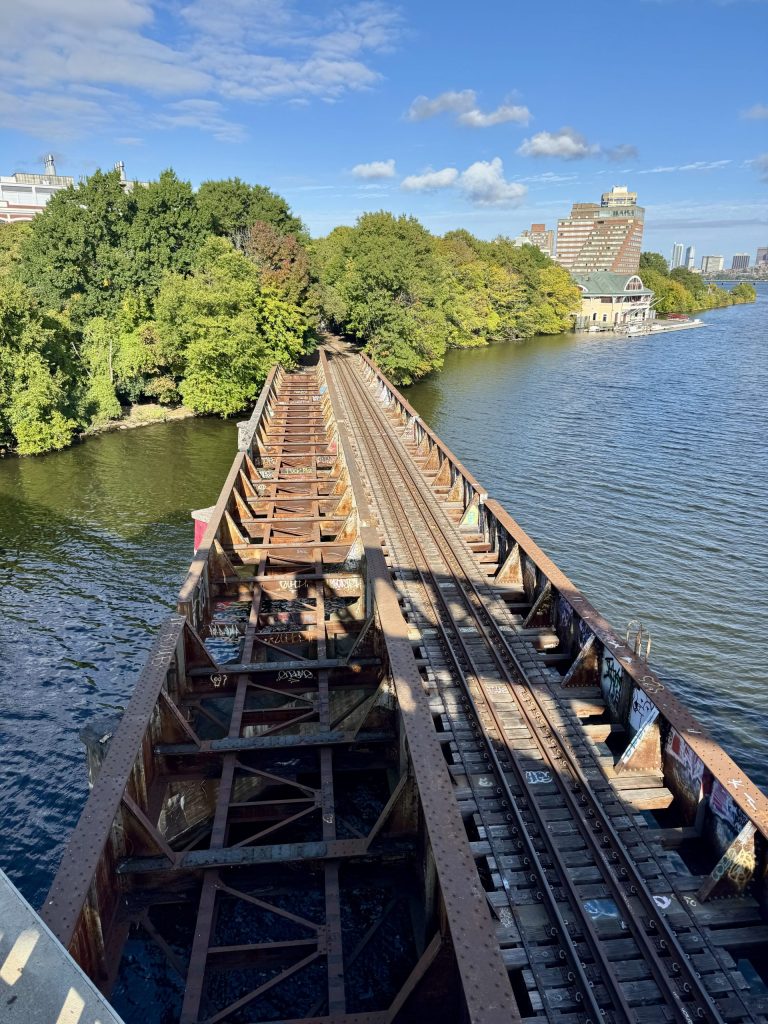GETTING TO KENDALL Square in Cambridge from the western suburbs isn’t easy. You can drive in on the Massachusetts Turnpike and take your chances with the brutal traffic in Cambridge, or you can ride all the way into Boston on either the commuter rail or the Green Line and then make your way out to Kendall from there.
There’s no more direct way, although a new study from the Cambridge Redevelopment Authority says there may be a better way.
A little-used rail line called the Grand Junction currently spins off from the commuter rail system near Boston University, crosses the Charles River via a railroad bridge to Cambridge, and then runs through Kendall Square en route to North Station. The Grand Junction is used only occasionally by the MBTA and Amtrak to transfer trains between the north and south sections of the commuter rail system.
The new study confirms what transit advocates have been saying for years – that the Grand Junction rail line could be converted for passenger use, ferrying riders from a proposed new MBTA station in Harvard University’s emerging research-oriented neighborhood in Allston to MIT, Kendall Square, and North Station. It would also allow far more direct travel to Worcester and points west as well as Everett, Chelsea, Revere, and Lynn to the north.
“Transit service between North Station and a future West Station [in Allston] would not only attract a substantial amount of existing ridership, but attract a great deal more travelers with the future growth planned in Kendall Square and Allston,” the Cambridge Redevelopment Authority said in a release accompanying the study. “This service would offer time savings for numerous existing commuters and also provide a vital cross-system connection within Boston’s largely radial rapid transit network.”
What’s unique about the study is that it goes into detail. Currently, the MBTA-owned right of way has a single track on much of the route, but the study says there is enough room to build two tracks, one in each direction. To do that, MIT would have to make room at two locations on property it owns, one at a cogeneration energy plant north of Massachusetts Avenue that spans over the existing track and a second at the university’s Brain & Cognitive Sciences Complex on Main Street.
The study recommends running electrified shuttle trains on the Grand Junction at intervals of every 15 to 20 minutes. It also calls for six stations along the core route, with a new West Station anchoring one end in Allston and North Station at the other end.
The study forecasts solid ridership and even takes a stab at the cost, estimating a pricetag for the core route to North Station in the range of $474 million to $570 million for trains running on electricity supplied by overhead wires and $475 million to $667 million for battery-powered trains. To extend service to Lynn, the cost would range from $708 million to $900 million for fully electric trains and $870 million to $1.25 billion for battery-powered vehicles.
There are all sorts of caveats attached to the analysis, with the two biggest being the completion of two major projects at each end of the proposed Grand Junction Line. One is a project that would expand the track capacity of North Station, which could make space for trains from the Grand Junction Line. The other is the I-90 Allston project, which reorients the Massachusetts Turnpike as it runs through Allston and repositions the Worcester commuter rail and Grand Junction lines to sync them up with a newly constructed West Station.
The North Station project in September received $472 million in federal funding to replace a train drawbridge and expand capacity, so that project will move forward. The I-90 Allston project, expected to cost as much as $1.9 billion, has received $335 million in federal funds and $300 million in commitments from the city of Boston, Harvard University, and Boston University.
The post Study explores rail link between Allston, Kendall Sq., and North Station appeared first on CommonWealth Beacon.

